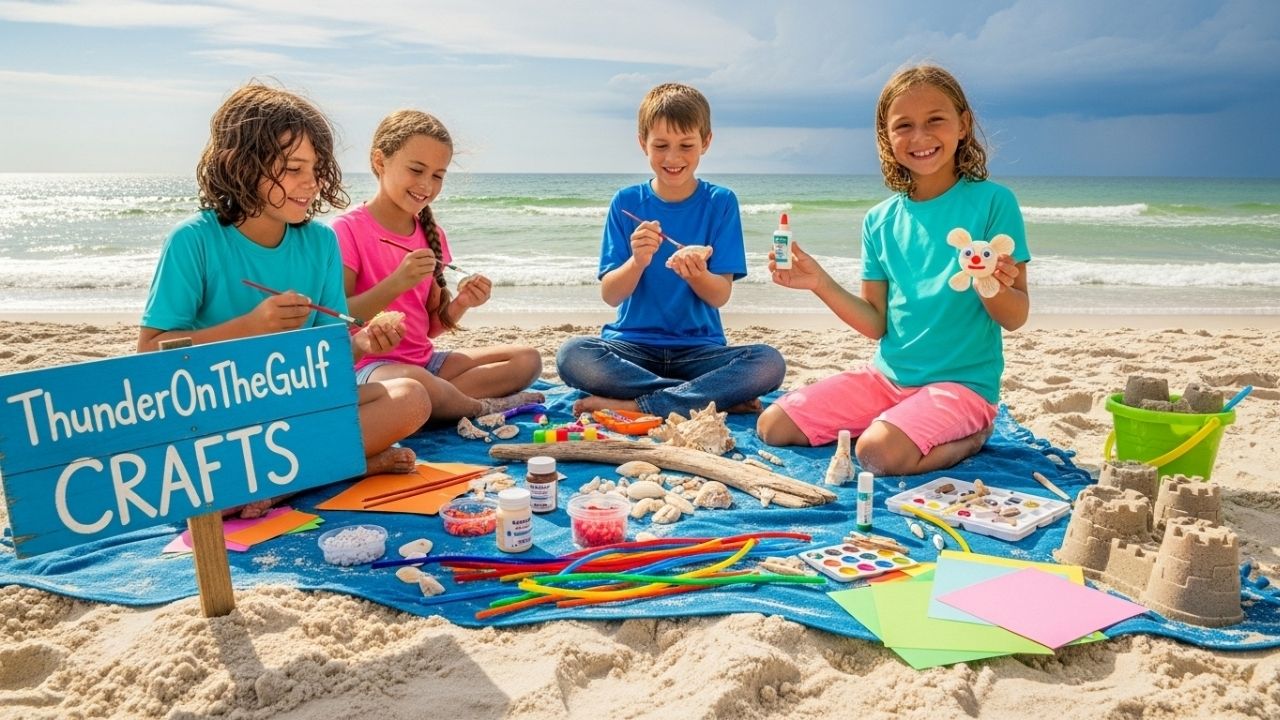Crafting is a joyful activity that sparks creativity, fosters learning, and strengthens family bonds. At ThunderOnTheGulf, we believe that engaging in DIY projects with kids not only provides fun but also introduces valuable skills and resourcefulness. In this comprehensive guide, we’ll explore practical tips, unique projects, and advanced techniques to help you embark on exciting crafting adventures with your little ones.
1. Gather Your Supplies
1.1 Essential Crafting Basics
Before diving into the world of crafting, it’s crucial to have the right supplies on hand. Here’s a list of essential materials that every crafting kit should include:
- Paper: Various types, including construction paper, cardstock, and recycled paper.
- Glue: Non-toxic white glue, glue sticks, and hot glue guns (with supervision).
- Scissors: Child-safe scissors for younger kids and sharper ones for older children.
- Markers and Paints: Washable markers, colored pencils, and non-toxic paints.
1.2 Scavenging for Craft Gold
One of the most exciting aspects of crafting is finding materials in unexpected places. Items you might consider trash can become treasures! Here are some tips on how to scout for supplies:
- Recycle Bin: Look for cardboard boxes, plastic containers, and glass jars.
- Kitchen Drawer: Old utensils, bottle caps, and fabric scraps can all be repurposed.
- Nature Walks: Collect leaves, twigs, and stones to incorporate into your crafts.
1.3 Organizing Your Craft Space
An organized workspace can enhance your crafting experience. Consider these tips:
- Use clear bins or baskets to separate different types of materials.
- Label everything to make it easy for kids to find what they need.
- Dedicate a specific area in your home as a crafting zone to minimize mess.
2. Simple Upcycled Crafts
2.1 Understanding Upcycling
Upcycling is a creative way to transform old items into new treasures. It not only saves money but also reduces waste. According to a report by the Environmental Protection Agency (EPA), Americans generated about 292.4 million tons of trash in 2018, with a significant portion being recyclable materials. By embracing upcycling, we can contribute to a more sustainable environment.
2.2 Ten Fun Upcycled Project Ideas
Here are ten easy upcycled craft ideas that you can enjoy with your kids:
- Painted Mason Jars as Vases: Transform glass jars into colorful vases for flowers.
- Cardboard Roll Napkin Rings: Decorate toilet paper rolls for fun napkin holders.
- Tin Can Planters: Puncture drainage holes and paint cans for unique plant pots.
- Old T-Shirts Braided into Rugs: Cut and braid old T-shirts into soft area rugs.
- Broken Jewelry Turned into Magnets: Glue pieces of broken jewelry onto magnets for a chic look.
- Wine Cork Bulletin Boards: Arrange wine corks in a frame to create a memo board.
- Plastic Bottle Bird Feeders: Cut openings in plastic bottles to make feeders for birds.
- Egg Carton Seed Starters: Use egg cartons to start seedlings for your garden.
- Magazine Page Paper Beads: Roll strips of magazine pages into colorful beads.
- CD Mosaic Photo Frames: Break old CDs into pieces and glue them onto a frame for a shiny mosaic effect.
2.3 Crafting Safety Tips
When working with kids, safety is paramount. Here are some important guidelines:
- Always use non-toxic materials and paints.
- Supervise children closely when using scissors or hot glue guns.
- Teach kids to clean up spills immediately to prevent accidents.
3. Seasonal Inspired Projects
3.1 Crafting Through the Seasons
Nature provides endless inspiration for crafting, with each season offering unique materials and themes. Seasonal crafting can help kids appreciate the changes in their environment and learn about nature’s cycles.
3.2 Seasonal Project Ideas
Here are some delightful seasonal projects to try:
- Fall: Create painted pumpkins and gourds using acrylic paints. This project can teach kids about using colors and patterns.
- Winter: Collect pine cones and twine to make festive ornaments. Discuss the importance of trees during winter.
- Spring: Press flowers between wax paper to craft beautiful bookmarks. This project can introduce kids to different types of flowers.
- Summer: Gather smooth stones from the beach and paint them as garden markers. Kids can learn about plant names and gardening.
3.3 Collecting Seasonal Materials
Encourage kids to collect materials during walks or at local markets. Keeping a seasonal craft basket at home ensures you have materials on hand when inspiration strikes. Consider using a small basket or tote bag to make collecting fun!
4. Kids Friendly Tutorials
4.1 Engaging Kids in Crafting
Crafting is an excellent way to blend playtime and learning. Here’s why it’s beneficial for kids:
- Creativity: Kids express themselves and develop their creativity.
- Fine Motor Skills: Crafting improves dexterity and coordination.
- Problem-Solving: Kids learn to think critically as they navigate projects.
4.2 Step-by-Step Crafting Process
Follow this structured approach to ensure a successful crafting session:
- Setting Up: Lay out all materials on a covered table to minimize mess.
- Explaining Steps: Use simple language to explain each step of the project.
- Demonstration: Show kids how to measure and cut shapes.
- Guiding Through Assembly: Help them with gluing and assembling pieces.
- Encouraging Decoration: Allow them to decorate freely, fostering self-expression.
4.3 Making Cleanup Fun
Cleaning up can be a part of the learning experience. Here are some tips to make it enjoyable:
- Turn cleanup into a game: Set a timer and see how quickly they can tidy up.
- Teach them to rinse brushes and toss scrap paper in a bin.
- Use fun songs to make cleaning feel less like a chore.
5. Advanced Craft Techniques
5.1 Elevating Your Crafting Skills
Once you and your kids have mastered the basics, it’s time to explore more advanced techniques that can elevate your projects. These methods require a bit of practice but can produce stunning results.
5.2 Detailed Techniques to Try
- Embossing: Use embossing powders and a heat gun to create textured designs on paper. Start with simple shapes and progress to more intricate patterns.
- Resin Casting: This technique involves embedding flowers or glitter in resin to create beautiful coasters or paperweights. Safety is key—always work in a well-ventilated area and wear gloves.
- Hand-Stitching: Teach kids basic stitches to create unique patchwork pillows or tote bags. This can be a great way to repurpose fabric scraps.
5.3 Resources for Learning
To help you and your kids improve your crafting skills, consider these resources:
- Online Tutorials: Websites like YouTube offer countless crafting tutorials for all skill levels.
- Crafting Forums: Join online communities to share ideas and receive feedback.
- Local Workshops: Look for crafting classes in your area that cater to families.
6. Display and Gifting
6.1 Showcasing Your Creations
Once your crafts are complete, displaying them can bring joy and pride. Here are some ideas for showcasing your work:
- Gallery Wall: Create a dedicated wall space to display your kids’ art. Use matching frames to create a cohesive look.
- Seasonal Displays: Change displays with the seasons to keep things fresh and engaging.
6.2 Thoughtful Gifting Ideas
Handmade gifts carry a personal touch that store-bought items often lack. Here are some creative ways to package your gifts:
- Eco-Friendly Wrapping: Use cloth or recycled paper to wrap gifts beautifully.
- Personalized Tags: Add a handwritten note or tag to each gift for a special touch.
6.3 Sharing Your Work Online
In today’s digital age, sharing your crafting journey online can inspire others. Here’s how to do it effectively:
- Social Media: Post photos of your projects on platforms like Instagram or Pinterest to reach a wider audience.
- Crafting Blogs: Consider starting a blog to document your crafting adventures and share tips with fellow crafters.
Conclusion
Crafting at ThunderOnTheGulf is more than just a fun activity; it’s an opportunity to explore creativity, learn new skills, and bond with your kids. By gathering supplies, embracing upcycling, and engaging in seasonal projects, you’ll discover endless DIY possibilities.
As you navigate this crafting journey, remember that the process is just as important as the finished product. Embrace mistakes, celebrate successes, and cherish the memories created along the way. So, gather those old buttons, dig into your recycle bin, and let your imagination soar. With these tips and a sprinkle of curiosity, every craft session becomes a chance to learn, share, and spark joy.

